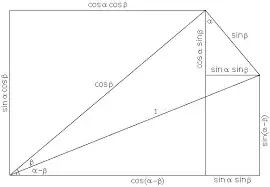For some reason I'm starting to get nit picky about everything I have learned. In Geometry/ Algebra I learned how to prove the angle sum formulas, which follow from this picture (and a slightly different picture with $a$ and $b$ instead of $\beta$ and $\alpha-\beta$ :
But now that I realize it this argument only works if the angle sum $x$ follows the inequality $0<x<\frac{\pi}{2}$. And every angle is larger than $0$, in radians.
How can we geometrically prove (to a high school student taking algebra/geometry) the trigonometric sum formulas but for all angles?
Definition
Here is what I'll take to be the definition of sine and cosine (if you know of another definition I'd appreciate it if you share):
Let $(x,y)$ be a point in the Cartesian plane, let $\theta$ be the counterclockwise angle in radians from the positive $x$ axis to the segment connecting $(x,y)$ to the origin. Let a clockwise angle of $\theta$ be equivalent to a counterclockwise angle of $-\theta$, and vice versa. Take "sin" and "cos" to be $2\pi$ periodic functions. Let $r$ be the distance from $(x,y)$ to the origin. In other words $r=\sqrt{x^2+y^2}$. Then define:
$$\sin (\theta)=\frac{y}{r}$$
$$\cos (\theta)=\frac{x}{r}$$
